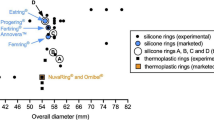Abstract
Vaginal rings (VRs) are new methods for continuous delivery of microbicides. This is the first study to quantitatively and qualitatively explore the acceptability of rings in Africa: 157 HIV-negative, sexually active women aged 18–35 used a placebo silicone elastomer ring for 12 weeks. They completed product acceptability questionnaires every 4 weeks. We conducted 6 exit focus group discussions with a subset of 48 women and 19 in-depth interviews with male partners. Retention in the study was high (97 %). Initial insertion at the clinic was successful on first attempt for 81 % of participants. Most women were comfortable using the ring, and very few (≤2 %) could feel it during daily activities or had ring-related physical or emotional problems. In the qualitative interviews many participants reported that they initially had concerns about using the ring. However, only a minority of women actually reported concerns with the ring during the study. The most frequent concern was that the ring would get lost inside the body (20 %), and this was significantly correlated with study site, frequently thinking about the ring and reporting that the ring was not very easy to remove. Qualitative data suggest that informants grew to like the ring because it felt securely placed, was unnoticeable during daily activities, and felt “normal” during sex. The ring appeared to be highly acceptable for women and men. Initial concerns with this novel method suggest a need for enhanced product counseling when VRs are introduced.


Similar content being viewed by others
References
UNAIDS. UNAIDS reports on the global AIDS epidemic 2010. 2010; Available from: http://www.unaids.org/globalreport/default.htm.
Nel A, Smythe S, Young K, Malcolm K, McCoy C, Rosenberg Z, et al. Safety and pharmacokinetics of dapivirine delivery from matrix and reservoir intravaginal rings to HIV-negative women. J Acquir Immune Defic Syndr. 2009;51(4):416–23.
Friend DR. Pharmaceutical development of microbicide drug products. Pharm Dev Technol. 2010;15(6):562–81.
Romano J, Variano B, Coplan P, Van Roey J, Douville K, Rosenberg Z, et al. Safety and availability of dapivirine (TMC120) delivered from an intravaginal ring. AIDS Res Hum Retrovir. 2009;25(5):483–8.
Tolley EE, Harrison PF, Goetghebeur E, Morrow K, Pool R, Taylor D, et al. Adherence and its measurement in phase 2/3 microbicide trials. AIDS Behav. 2010;14(5):1124–36.
Abdool Karim Q, Abdool Karim SS, Frohlich JA, Grobler AC, Baxter C, Mansoor LE, et al. Effectiveness and safety of tenofovir gel, an antiretroviral microbicide, for the prevention of HIV infection in women. Science. 2010;329(5996):1168–74.
Merkatz RB, Tokay B, Sitruk-Ware RL. Methods for female contraception: a model for innovation in drug delivery systems. Clin Pharmacol Ther. 2009;85(5):553–7.
Novak A, de la Loge C, Abetz L, van der Meulen EA. The combined contraceptive vaginal ring, NuvaRing: an international study of user acceptability. Contraception. 2003;67(3):187–94.
Shimoni N, Westhoff C. Review of the vaginal contraceptive ring (NuvaRing). J Fam Plan Reprod Health Care. 2008;34(4):247–50.
Madden T, Blumenthal P. Contraceptive vaginal ring. Clin Obstet Gynecol. 2007;50(4):878–85.
Sabatinia R, Cagiano R. Comparison profiles of cycle control, side effects and sexual satisfaction of three hormonal contraceptives. Contraception. 2006;74:220–3.
Nath A, Sitruk-Ware R. Progesterone vaginal ring for contraceptive use during lactation. Contraception. 2010;82(5):428–34.
Hardy E, Hebling EM, Sousa MH, Almeida AF, Amaral E. Delivery of microbicides to the vagina: difficulties reported with the use of three devices, adherence to use and preferences. Contraception. 2007;76(2):126–31.
Stewart FH, Brown BA, Raine TR, Weitz TA, Harper CC. Adolescent and young women’s experience with the vaginal ring and oral contraceptive pills. J Pediatr Adolesc Gynecol. 2007;20(6):345–51.
Smith DJ, Wakasiaka S, Hoang TD, Bwayo JJ, Del Rio C, Priddy FH. An evaluation of intravaginal rings as a potential HIV prevention device in urban Kenya: behaviors and attitudes that might influence uptake within a high-risk population. J Womens Health (Larchmt). 2008;17(6):1025–34.
Woodsong C, Montgomery E, Masenga G, Mollendorf C, Bekker L, Ganesh S, et al., editors. Safety and acceptability of vaginal ring as microbicide delivery method in African women. International partnership for microbicides. Silver Spring, MD; 2010.
Nel A, Young K, Romano J, Woodsong C, van der Straten A, Masenga G, et al. Safety and acceptability of silicone elastomer vaginal rings as potential microbicide delivery method in African women. International partnership for microbicides. Silver Spring, MD; 2011.
Simons-Rudolph A, Woodsong C, Koo H. Modeling the social context of microbicide use. Microbicide Q. 2008;6(4):1–11.
Woodsong C, Alleman P. Sexual pleasure, gender power and microbicide acceptability in Zimbabwe and Malawi. AIDS Educ Prev. 2008;20(2):171–87.
Sahin-Hodoglugil N, Montgomery ET, Kacanek D, Morar NS, Mtetwa S, Nkala B, et al. User experiences and acceptability attributes of the diaphragm and lubricant gel in an HIV prevention trial in Southern Africa: a theory based qualitative analysis (under review). 2010.
Woodsong C, Simons-Rudolph A, Alleman P. A comprehensive and flexible conceptual framework for investigating acceptability in microbicide clinical trials (poster presentation). Microbicides 2008. Delhi, India; 2008.
Montgomery ET, van der Straten A, Cheng H, Wenger L, Mesanga G, Rees H, et al. Vaginal ring adherence in sub-saharan Africa: expulsion, removal, and perfect use. International AIDS conference 2011, July 17–20, Rome, Italy 2011.
Bhaduri M, Carr LK, Dunn S, Glanc P. The vaginal ring: expelled or misplaced? J Ultrasound Med. 2009;28(2):259–61.
Kang MS, Buck J, Padian N, Posner SF, Khumalo-Sakutukwa G, van der Straten A. The importance of discreet use of the diaphragm to Zimbabwean women and their partners. AIDS Behav. 2007;11(3):443–51.
Averbach S, Sahin-Hodoglugil N, Musara P, Chipato T, van der Straten A. Duet® for menstrual protection: a feasibility study in Zimbabwe. Contraception. 2009.
Mantell J. Women in the time of AIDS: barriers, bargains, and benefits. AIDS Educ Prev. 2008;20(2):91–106.
Green G, Pool R, Harrison S, Hart GJ, Wilkinson J, Nyanzi S, et al. Female control of sexuality: illusion or reality? Use of vaginal products in south west Uganda. Soc Sci Med. 2001;52(4):585–98.
Grant RM, Lama JR, Anderson PL, McMahan V, Liu AY, Vargas L, et al. Preexposure chemoprophylaxis for HIV prevention in men who have sex with men. N Engl J Med. 2010 Nov 23.
Nel A, Kamupira M, Woodsong C, Montgomery E, Nuttall J, editors. Safety, acceptability, and adherence of monthly dapiravine vaginal microbicide rings for HIV prevention. 19th conference on retroviruses and opportunistic infections (CROI 2012), 2012 March 5–8, 2012, Seattle, WA.
Woodsong C, Shedlin M, Koo H. The ‘natural’ body, God and contraceptive use in the southeastern United States. Culture Health Sex. 2004;6(1):61–78.
Stadler J, Saethre E. Blockage and flow: intimate experiences of condoms and microbicides in a South African clinical trial. Culture Health Sex. 2011;13(1):31–44.
Acknowledgments
We would like to acknowledge the women who participated in this study, the IPM 011 study team, and to extend special thanks to the research sites’ clinical and social science teams in Moshi, Johannesburg, Durban, and Cape Town. This work was supported by the International Partnership for Microbicides (IPM).
Author information
Authors and Affiliations
Corresponding author
Additional information
RTI International is a trade name of Research Triangle Institute.
Rights and permissions
About this article
Cite this article
van der Straten, A., Montgomery, E.T., Cheng, H. et al. High Acceptability of a Vaginal Ring Intended as a Microbicide Delivery Method for HIV Prevention in African Women. AIDS Behav 16, 1775–1786 (2012). https://doi.org/10.1007/s10461-012-0215-0
Published:
Issue Date:
DOI: https://doi.org/10.1007/s10461-012-0215-0




